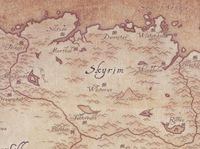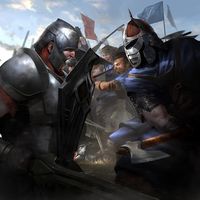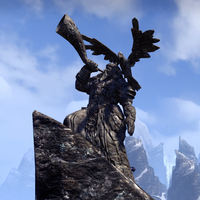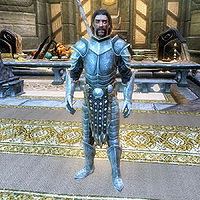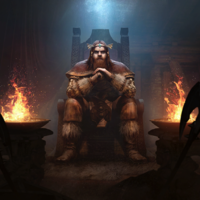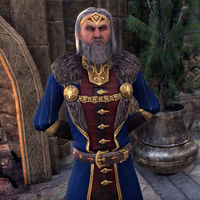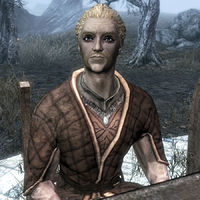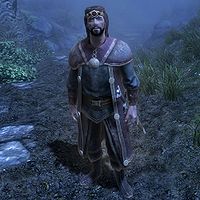Lore:Kingdoms of Skyrim
| It has been suggested that this article be merged with Lore:Skyrim#History. (Discuss) |
The Kingdoms of Skyrim have a rich and bloody history. Skyrim, the northernmost province of Tamriel, is a cold and mountainous region also known as the Old Kingdom, Mereth, or the Fatherland,[1][2] or Keizaal in the dragon tongue.[3] Many past battles have given it a ravaged appearance and many ruins.[1][4] Though currently inhabited primarily by Nords, the Elves who they replaced had resided there since time immemorial.[1][4] The sovereign, the High King of Skyrim, is chosen by the Moot, a convention of jarls.[5] A jarl is a regional ruler chosen through heredity and, rarely, through right of arms.[5][6] The High King typically rules until death, though acts of dishonor, particularly the appearance of cowardice, can lead to the recall and reconsideration of the Moot.[5][7] Since the Pact of Chieftains was signed in 1E 420, the Moot does not give serious consideration to anyone but the High King's direct heir unless one is not available.[1]
First Empire of the Nords[edit]
The First Empire of the Nords, also known as the Nord Empire, is the collective term for the Nordic kingdom during a phase of expansion in the First Era, known as the Skyrim Conquests. Its capital was the city of Windhelm in Skyrim, where a First Empire palace still stands. The empire was formed when King Vrage the Gifted began a campaign to conquer High Rock and Morrowind (a feat that is attributed by some to Sai, the God of Luck) circa 1E 240. By the end of the conquests, the First Empire of the Nords encompassed Skyrim, parts or all of High Rock (sources conflict), Morrowind with the exception of the Dwemer kingdom of Vvardenfell, and a large portion of Cyrodiil's Nibenay Valley. These invasions upset the balance in High Rock and Cyrodiil, and although the Nords' empire lasted less than two centuries, the result was decisive; from then on, power in those regions shifted from the elves to the humans.
Though the last ruler, King Borgas, died in 1E 369, the ultimate end of the First Nordic Empire came in 1E 420, when the Pact of Chieftains ended the War of Succession and the empire finally shattered; Skyrim eventually lost all of its holdings in Morrowind, Cyrodiil, and High Rock, and many of the Nordic kingdoms began to declare independence. The Nords were driven from Morrowind by force when Indoril Nerevar and Dumac Dwarfking joined together, repelling the invaders in 1E 416.
In the aftermath of the war in 1E 420, it became evident the former system of succession, known as the Moot, had become partisan and ineffective. When King Olaf died without a clear heir a new method of electing a High King became necessary.[1] This new method involved the creation of the Crown of Verity - a magical artifact used to test the worthiness of potential rulers of Skyrim. Throughout the remainder First Era, the Crown of Verity was been passed down from High King to High King, used as a tool by the Moot to ascertain the worthiness of any candidate for the throne.[8]
While the new system of succession was purported to be an overwhelming success in later eras (to the degree that Skyrim's leadership was supposedly never disputed on the field of battle in the following 3,000 years), this was not entirely true.[1][8] For brief periods, a single ruler managed to unite all of Skyrim, but the Nord character is one essentially of conflict, and the confederacies never lasted.[9] For example, in the late-First Era High King Irthvyd of Solitude died without an heir. His senior advisor, Temylda ascended the throne after duelling several jarls in single combat. Forty years later, Temylda's reign ended and a new leader was chosen out of bloodshed and violence. The warrior Alldimar, known for his many skirmishes with the Reachmen, wrestled the title from an untested child heir using his years of knowledge in arcane magic and his great sense of warfare.[10]
When the Second Empire was established in 1E 2704, Skyrim was either conquered or allied with Reman I relatively quickly as troops from Solitude were frequently sent into the Reach to pacify rebellious Reachmen.[11] Despite now being part of the Second Empire, Skyrim's retained their ancient system of leadership with Jarls, High Kings, and succession using the Crown of Verity.[8]
Interregnum[edit]
After the Second Empire fell, High King Logrolf was assassinated 2E 431 heralding a major change in Skyrim. Naturally, the throne would have been passed to the High King's heir, Jarl Freydis of Windhelm. However, tension had arisen between the east and west when Jarl Svartr of Solitude had challenged her claim to leadership and thus called for a moot. Freydis was accepted by the Crown of Verity and named High Queen, though part of the Moot chose Svartr as High King. What followed was a decisive schism that split Skyrim in two, creating distinct Western and Eastern Kingdoms.[12][13]
The Kingdom of Eastern Skyrim briefly became part of a greater alliance called the Ebonheart Pact during the mid-Second Era. During the Second Akaviri Invasion in 2E 572, the city of Windhelm was sacked and Queen Mabjaarn and her heir Nurnhilde were slain, leaving the crown to Mabjaarn's son, Jorunn.[14] In an unprecedented show of cooperation between races with a great deal of historical enmity, the Nords, Dunmer and Argonians fought together to encircle the Akaviri forces in Stonefalls and drove the invaders back into the sea. This allegiance forged in battle was ratified with treaties, and thus the Ebonheart Pact was born.[15]
Eastern Skyrim fought in the Three Banners War as a member of the Ebonheart Pact, while under High King Svargrim, Western Skyrim remained neutral.[16] At that time, The Reach did not belong to either kingdom and the Reachmen had banded together under the Despot of Markarth, who allied himself with Mannimarco.[17]
By 2E 582 Western Skyrim would come under threat with the reemergence of the Gray Host. The Vestige traveled to Western Skyrim where they saved Solitude from a harrowstorm. Due to the chaos caused by the Gray Host, Queen Gerhyld was assassinated. Princess Svana, Svargrim's daughter, and the Vestige confronted Svargrim after discovering he was a pawn of the Gray Host and managed to defeat him before he could devastate the realm.[18][19]
At an unknown point of time the Ebonheart Pact dissolved.
The Tiber War[edit]
The two kingdoms of Skyrim, as well as The Reach, were eventually reunified into a single realm following the Tiber War.[20][21]. In the last days of the Interregnum, a petty king of the Colovian Estates, Cuhlecain, came to power alongside the leader of his legions, General Talos. A year later more than half of the Cyrodilic Empire was reclaimed or consolidated, and Cuhlecain captured the Imperial City and proclaim himself Emperor. Skyrim and High Rock, which bitterly opposed a return to Cyrodilic rule, gathered their armies for a joint invasion of the Colovian West. Talos met them on the field of Sancre Tor. The Nords that had come to oppose the Empire soon joined the General's forces, for when they heard his Thu'um they believed him to be a son of Skyrim and the heir to the Empires of Men. Cuhlecain was soon assassinated soon after and Tiber Septim rose to power, eventually conquering all of Tamriel.[1]
Third and Fourth Eras[edit]
As with the Second Empire, Skyrim retained many its ancient customs of leadership as a province under Tiber Septim, and was considered the Empire's "strong arm".[5][9] Traditionally each Hold was ruled by a Jarl who in turn were ruled by the High King, but ultimately the High King swore fealty to the Emperor. Solitude became the city most directly influenced by Imperial culture and politics, thus it became the capital city and its Jarl served as the Imperial-sanctioned High King for centuries thereafter.[5][22] Indeed, many of Solitude's Jarls were connected to the Septim bloodline, such as Potema, the "Wolf Queen of Solitude".[23] As such, the Moot (and by extension the Crown of Verity) became formality and theater as opposed to official succession, leading some to view Skyrim's ruler as a puppet.
At times, some hold capitals were sometimes referred to as kingdoms in their own right, and their Jarls referred to as kings or queens, particularly by outsiders.[24][25] For example, the city of Solitude was oft referred to as the Kingdom of Solitude during the Third Era, or Queen Macalla of Dawnstar, who married King Thian of Solitude.[9]
In 4E 15, the Stormcrown Interregnum began, engulfing the Empire in chaos. After seven long, bloody years, the Stormcrown Interregnum was ended when a Colovian warlord named Titus Mede seized the crown in 4E 22. He proved a shrewd and capable leader, such that Skyrim endorsed him as Emperor. By 4E 168, the Empire was greatly weakened, but Skyrim was one of the few provinces that remained prosperous and peaceful.[26][27]
That changed during the Great War, when Reachmen briefly seized Markarth and most of the Reach in 4E 174 in an uprising, however a militia led by Ulfric Stormcloak retook the hold two years later.[28] However this would pale in comparison to the Stormcloak Rebellion in 4E 201 - an event that drastically shifted in the political landscape and plunged Skyrim into another civil war. Jarl Ulfric Stormcloak, seeking independence from Imperial rule, killed High King Torygg resulting in the province being split two. One side vying for independence and a return to the old ways, and the other seeking to remain under the rule of the Empire.[29]
Known Rulers[edit]
The political structure of the Elves who first inhabited Skyrim is unknown. When the Atmorans first migrated to Skyrim, before the Dragon War of the Merethic Era, the Dragon Priests of the Dragon Cult held roles on par with kings, but the Atmorans recognized relatively secular chieftains as their leaders.[1][30] Ysgramor is the first known human ruler of Skyrim.[1] His progeny would continue to rule after his death as the Ysgramor Dynasty; King Harald, the 13th of his line, is considered the first "historical" ruler.[31][32] Since Harald's time or even before, the High King traditionally wore the Jagged Crown, though it was lost with King Borgas in 1E 369 until its rediscovery in 4E 201.[6] A new symbol of rulership, the Crown of Verity, later called the Crown of Freydis, was crafted to determine the worthiness of potential rulers following the death of Olaf One-Eye, but has not been seen beyond the Second Era.[12] Known High Kings/Queens and their reigns are listed below:
Gallery[edit]
Notes[edit]
- ^ During the War of Succession there was no High King for approximately 51 years.
- ^ Rislav The Righteous states that Kjoric the White was killed eight months before certain events in 1E 478, placing his death either in that year or in 1E 477.
- ^ Hoag Merkiller was said to have died at the Battle of Glenumbria Moors, after which Wulfharth ascended to the throne. However, some sources place the date of the battle at 1E 480, and others at 1E 482.
- ^ Gellir could not have reigned any earlier than 1E 533. His chief accomplishment is the conquest of Skyrim's Dwemer city-states, and according to Arkngthamz-Phng, those city-states were not established until the decades after Clan Rourken founded Volenfell in 1E 420. Since the consecutive reigns of four other High Kings span the years between 1E 420 and 1E 533, Gellir could only have ruled sometime after 1E 533. The Aetherium Wars notes that the Dwemer reclaimed their lands "a century" after Gellir's conquests, and since the Dwemer had disappeared by 1E 700, it is likely that Gellir's reign occurred before the end of the 6th Century of the First Era.
- ^ This unidentified descendant of Temylda was crowned High King forty years after Temylda's death while still a child. He was quickly usurped by Alldimar the Ghostmaker according to Scandals of Solitude's Royalty.
- ^ Skyrim split into independent Eastern and Western kingdoms in 2E 431 amid a dispute over the succession. Freydis was proclaimed High Queen in Windhelm, and her successors (who include Mabjaarn Flame-Hair, Nurnhilde, and Jorunn the Skald King) ruled Eastern Skyrim. Svartr was proclaimed High King in Solitude, and his successors ruled Western Skyrim.
- ^ The map of PGE1 displays Winterhold as the capital of Skyrim Province.
- ^ During the Stormcloak Rebellion there was no High King. The kingship was claimed both by the rebel leader Ulfric Stormcloak, Jarl of Windhelm, who killed the previous High King Torygg, and by Torygg's widow Elisif the Fair, Jarl of Solitude, who was supported by the Empire.
References[edit]
- ^ a b c d e f g h i j k l m Pocket Guide to the Empire, 1st Edition: Skyrim — Imperial Geographical Society, 2E 864
- ^ Provinces of Tamriel
- ^ Odahviing's dialogue
- ^ a b Pocket Guide to the Empire, 3rd Edition: The Throat of the World: Skyrim — Imperial Geographical Society, 3E 432
- ^ a b c d e Skyrim's Rule — Abdul-Mujib Ababneh
- ^ a b c Events of Skyrim
- ^ a b c Sybille Stentor's dialogue in Skyrim
- ^ a b c The Crown of Freydis — Taleon Mythmaker
- ^ a b c Pocket Guide to the Empire, 3rd Edition — Imperial Geographical Society, 3E 432
- ^ Scandals of Solitude's Royalty — Erisa Sylbenitte of the Coterie of Organized Scholars
- ^ The Improved Emperor's Guide to Tamriel: Northern Bangkorai and the Mountains — Flaccus Terentius, 2E 581
- ^ a b c d e f g h The Crown of Freydis — Taleon Mythmaker
- ^ Meet the Character - High King Svargrim — Pjetr the Skald, of the Bards College
- ^ a b Jorunn the Skald-King — Helgreir Lute-Voice, Bard of Windhelm
- ^ Unexpected Allies
- ^ The Second Akaviri Invasion — Yngmaer Raven-Quill, Historian Royal of the Bards' College, Solitude
- ^ The Improved Emperor's Guide to Tamriel: Skyrim — Flaccus Terentius, 2E 581
- ^ Events of Greymoor Rising in ESO: Greymoor
- ^ Greymoor Rising
- ^ The Arcturian Heresy — The Underking, Ysmir Kingmaker
- ^ Kibell's dialogue in Skyrim
- ^ Thaer's dialogue in Skyrim
- ^ Loading screen in Skyrim
- ^ Biography of the Wolf Queen — Katar Eriphanes
- ^ Legate Taurinus Duilis' dialogue in Skyrim
- ^ Rising Threat, Vol. IV — Lathenil of Sunhold
- ^ The Great War — Legate Justianus Quintius
- ^ The Bear of Markarth — Arrianus Arius, Imperial Scholar
- ^ Nords Arise! — Anonymous
- ^ The Dragon War — Torhal Bjorik
- ^ a b c Frontier, Conquest — University of Gwylim Press, 3E 344
- ^ The Annotated Anuad
- ^ a b Falkfyr's Complete Report — Scout Falkfyr
- ^ Fanciful Map of the Rift item description
- ^ a b c d e f Plaque in Windhelm
- ^ a b c The Daggerfall Chronicles — Ronald Wartow
- ^ King Edward, Part X — Anonymous
- ^ a b A History of Daggerfall — Odiva Gallwood
- ^ Olaf and the Dragon — Adonato Leotelli
- ^ a b Walking the World, Vol XI — Spatior Munius
- ^ The Aetherium Wars — Taron Dreth
- ^ On Oblivion — Morian Zenas
- ^ a b c d e f g h i j Scandals of Solitude's Royalty — Erisa Sylbenitte of the Coterie of Organized Scholars
- ^ Crafting Motif 4: Nord Style — Doctor Alfidia Lupus
- ^ Oengul War-Anvil's dialogue in Skyrim
- ^ a b c d e f The Brothers' War
- ^ a b c Second Invasion: Reports
- ^ a b c Events of ESO
- ^ Jakolar's Journal — Jakolar
- ^ Appearance of Jarl Svana in ESO
- ^ a b The Wolf Queen, v8 — Waughin Jarth
- ^ Biography of the Wolf Queen — Katar Eriphanes
- ^ Solstheim loading screens in Skyrim: Dragonborn
- ^ Events of Skyrim The Adventure Game
Note: The following references are considered to be unofficial sources. They are included to round off this article and may not be authoritative or conclusive.
| |||||
